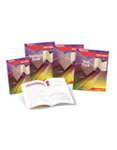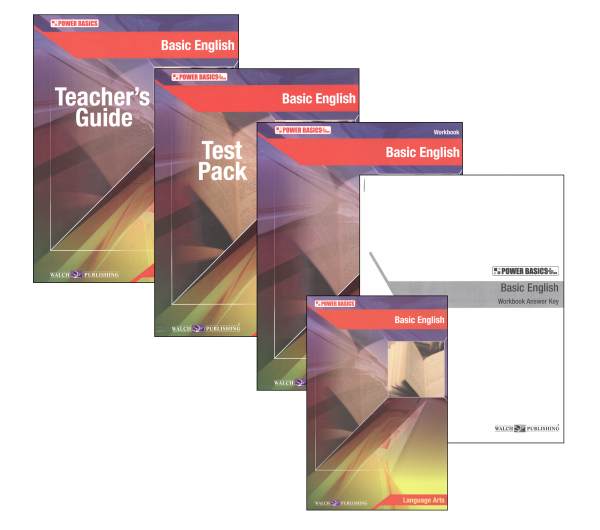Basic English and the other "Power Basics" courses are written for students in grades 6 through 12. These courses try to cover the basic content students need to master but in a simplified fashion. Reading level for "Power Basics" is about fourth-fifth grade. Student worktexts are 6" x 9" with relatively large print so there is significantly less content per page than in standard textbooks. These courses might be used for remedial work, for students with learning difficulties, or as brief overview courses for students who simply haven't studied the subject matter.
The five components you need for each course are a student book, student book teacher's guide, workbook, workbook answer key, and test pack. (The publisher sells these five items as a "single pack.") The student book is a consumable worktext; students write some responses directly in the book although the bulk of their written work is done in the workbook. Student workbooks are 8.5" x 11". Although their font size is smaller than the student text, they still have reasonably large spaces for written responses and do not appear overwhelming.
Even though the student book teacher's guide has some instructional information, the courses are really set up so that students can work independently for the most part with parents/teachers correcting work and administering tests. The teacher's guide serves as the answer key to the student text. The test pack includes its own answer key. There is a separate key for the workbook. The "single pack" with all five items is sold by the publisher for $59.99.
Basic English is divided into four sections: parts of speech, parts of sentences (subjects, predicates, complements, and clauses), usage, and mechanics (capitalization and punctuation). Instructional methodology is similar to that of many grammar books: brief explanation of a rule, examples and explanation, followed by practice exercises. Additional exercises for each topic are in the workbook.
The amount of instruction is necessarily limited in this 166-page book. It doesn't go into very complex or unusual examples. There's no sentence diagramming. Instruction on "capitalization" serves as an example. Capitalization is taught within a single lesson. It has rules only for capitalization of the first word in a sentence or quotation, capitalization in titles, and capitalizing "I" and proper nouns and proper adjectives. Only two examples of proper adjectives are provided. Students would have to consult a more comprehensive resource to learn about capitalization in regard to ethnic groups, religions, and geographical references. Nevertheless, there's something to be said for just sticking to the basics and not overwhelming students with details they might not recall anyway.










